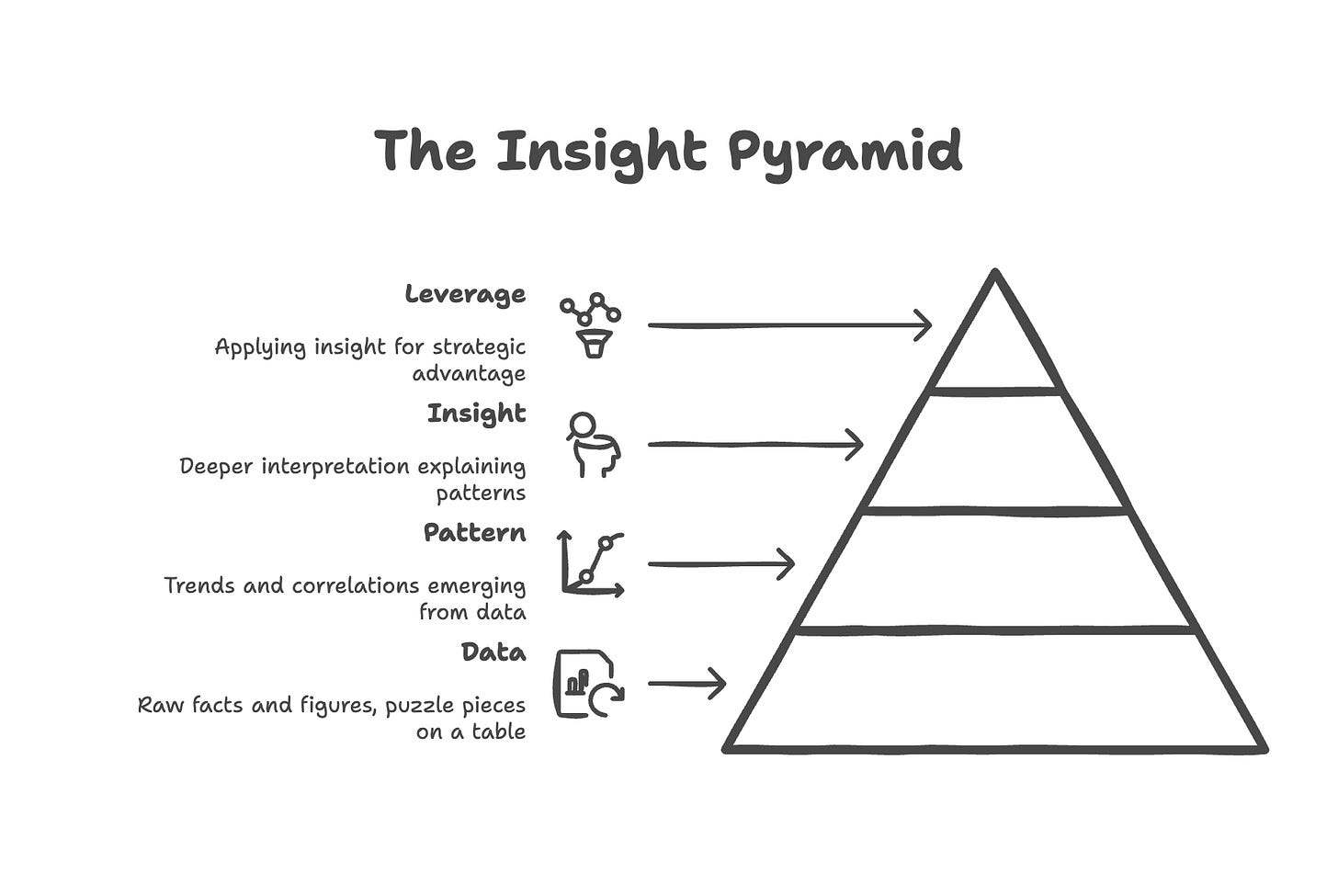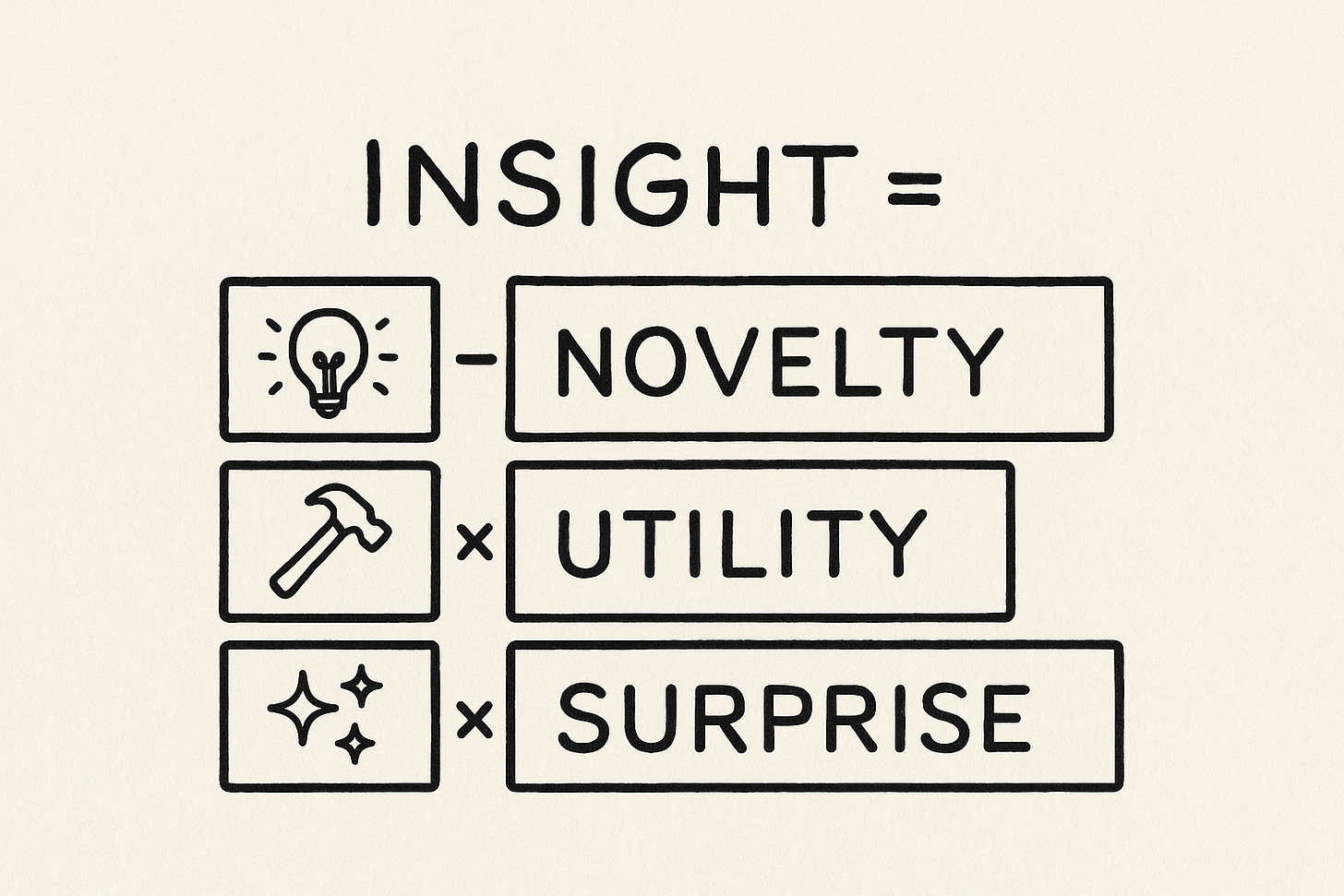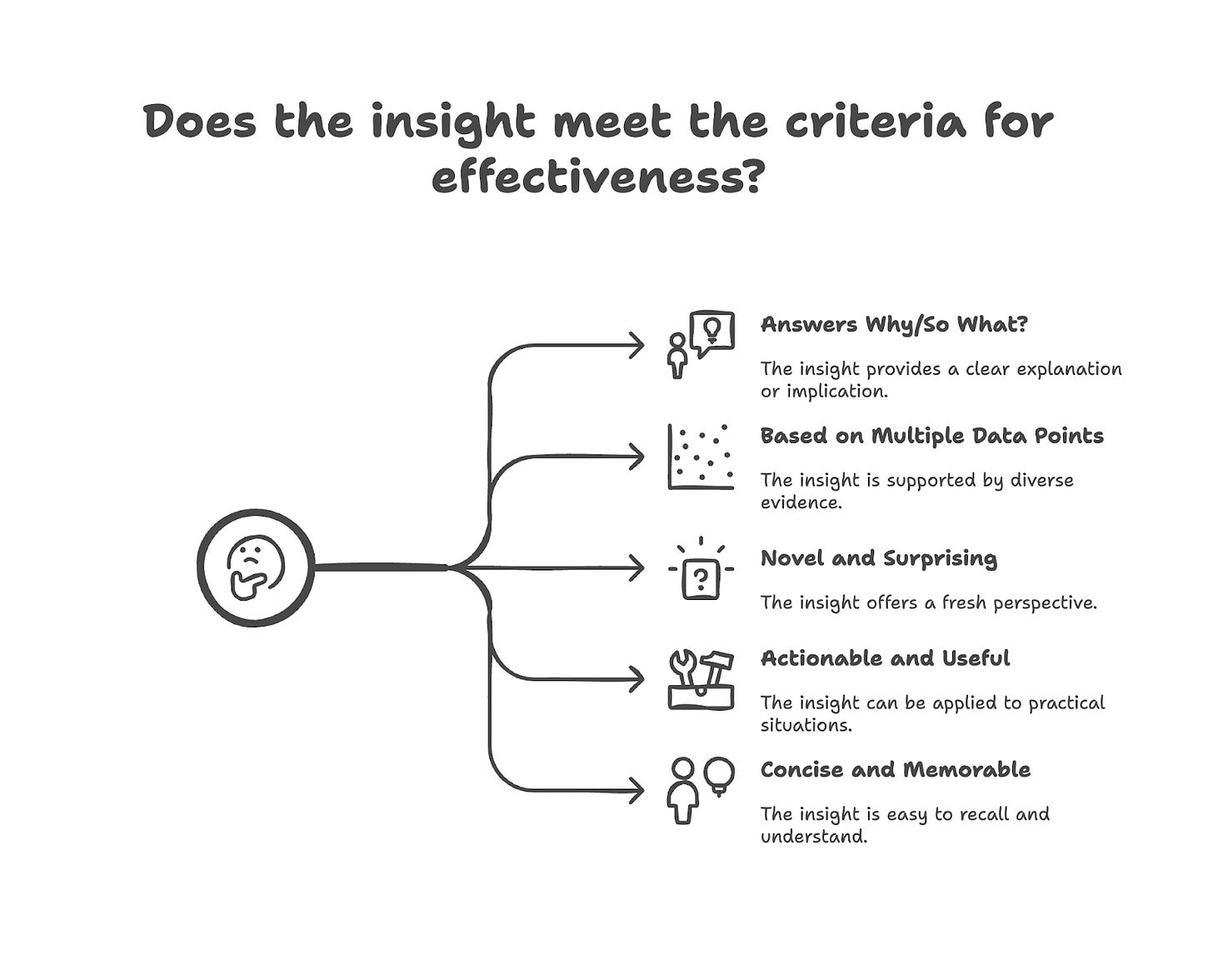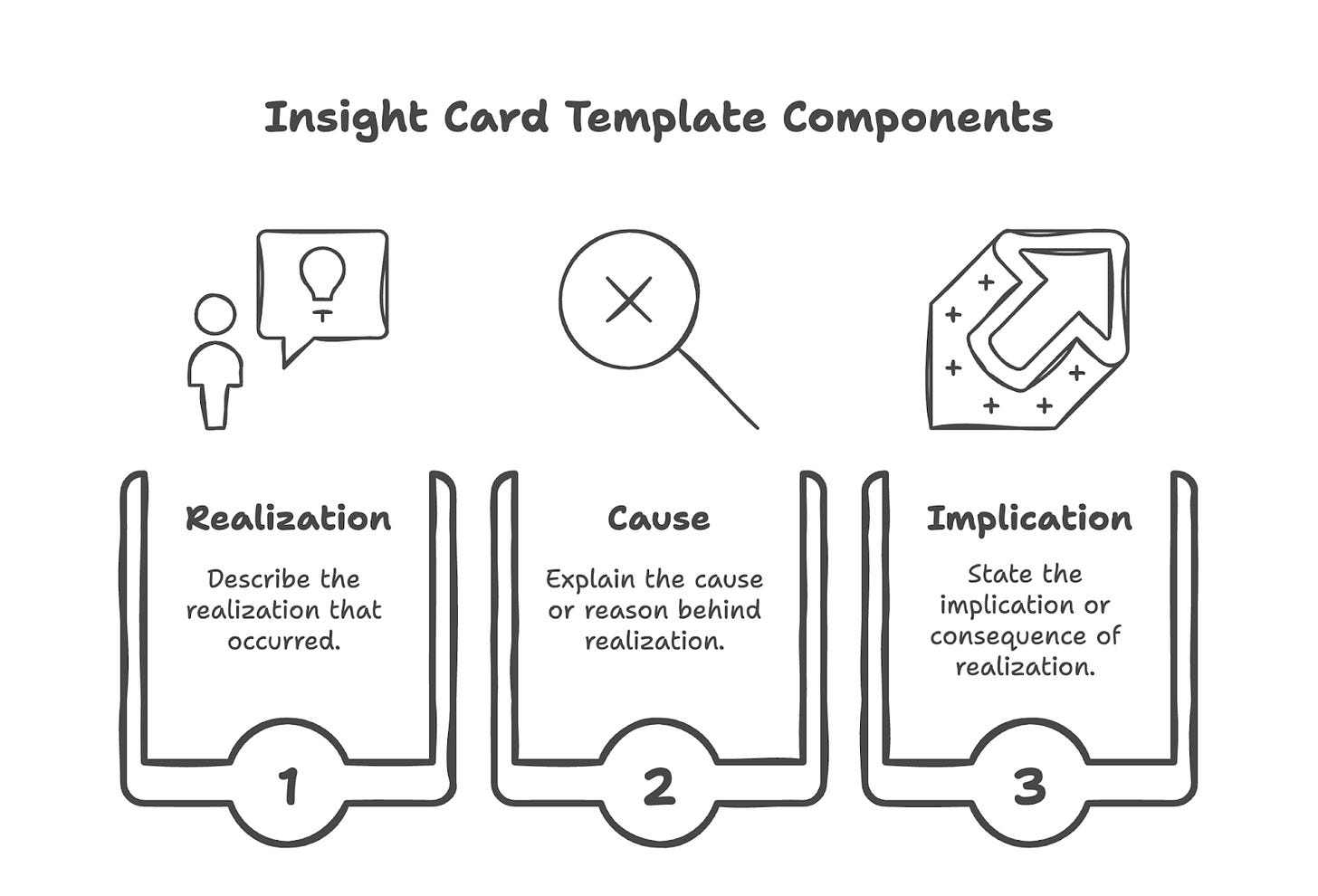Observation Isn’t Insight.
Here’s the Difference (and Why It Matters)
We’ve all been there.
You’re in a meeting. Someone says, “We had 1 million impressions on our latest post. That’s a great insight!”
Everyone nods like it’s the second coming of Einstein.
But you? You’re sitting there thinking… that’s just a number, bro.
Because it is.
That’s not insight. That’s an observation wearing a trench coat trying to sneak into the Strategy Club.
And honestly? This confusion is everywhere: pitch decks, marketing reports, even LinkedIn thought leadership posts. (You know the ones.)
This isn’t just a language problem.
Confusing observations for insights can derail decision-making, lead to bad strategies, and waste everyone’s time.
We’re drowning in dashboards and mistaking volume for clarity. In a world that fetishizes data, the people who rise are the ones who can turn noise into signal, fast.
The Insight Pyramid: From Data to Leverage
Most people live at the bottom of the pyramid.
Smart people climb to the top.
Here’s what that looks like:
Step 1: Data
Raw facts. Metrics. Numbers.
“We had 50,000 site visitors last month.”
Useful? Sure. Insightful? Not even close.
Don't confuse reporting with thinking. Data is step zero, not step five.
Step 2: Pattern
You start noticing trends.
“Traffic jumps every time we post how-to guides.”
Now we’re getting somewhere.
Ask: What’s repeating? What’s changing together? Look for clusters, not just dots.
Step 3: Insight
Now ask why.
“Turns out, how-to guides attract beginner users looking for support, not just inspiration. We’ve tapped into an underserved segment.”
That’s insight. It’s non-obvious, useful, and directional.
Take every pattern and follow up with: “Why is this happening?”
If you can’t answer it clearly, you’re not done yet.
Step 4: Leverage
Insight is cool. But insight + action? That’s power.
“We should launch a beginner onboarding series and capture this demand loop.”
Don’t stop at the lightbulb moment. Ask: What lever can we now pull?
TL;DR Pyramid Climb Checklist:
List raw facts
Find a pattern
Ask why
Decide how to act
The further up you go, the sharper your thinking gets. That’s where the good stuff (and the good decisions) live.
So What Is an Insight, Really?
It’s not just “a good thought.”
It’s not “something that sounds clever.”
It’s definitely not “that one line your manager bolded in the report.”
Here’s what a real insight actually is:
Insight = Novelty × Utility × Surprise
(If any one of those is zero, your insight is too.)
Let’s break it down:
Novelty: “I’ve never heard it framed that way before.”
Your insight needs to feel fresh.
Not regurgitated from a McKinsey deck from 2004.
Example:
“People love snacks.” (Zzz.)
“People are using snacks as temporal anchors, a sense of structure in chaotic WFH days.” (Now we’re talking.)
If it sounds like something your team already agrees on by default, it’s not novel enough. Reframe till it lands differently.
Utility: “I can do something with this.”
Insight isn’t an art piece. It’s a tool.
If your team reads it and asks, “Cool, but now what?”, you’ve got more work to do.
Example:
“This tells us we should adjust pricing for first-time users.”
“Let’s A/B test this new CTA for trust-building.”
Test your insight by following it up with: “So what should we do?” If the answer is “uhhh,” it’s not actionable yet.
Surprise: “Huh. Didn’t expect that.”
The best insights give you that little jolt. A raised eyebrow.
Something clicks. It reveals a why you hadn’t considered.
Example:
“Busy parents don’t skip workouts because they’re tired. They skip them because that’s the only time they get with their kids and they feel guilty.”
That’s surprise. That’s empathy. That’s insight.
If your takeaway makes everyone nod and no one pause, it might be too safe.
You want the head-tilt. The “wait, really?” That’s your bar.
Quick Test: Is it really an insight?
Try this:
Have I heard it before? If yes, probably not novel.
Can we act on it today? If no, it’s just a fancy observation.
Did it make me say “Huh!”? If no spark, no insight.
So What Happens When You Use This?
Here’s what this looked like in practice at WTFund:
We were running closed founder circles. Intimate sessions. Safe spaces.
But session after session, we noticed something.
The women founders in the room weren’t asking questions.
They were listening, nodding, taking notes. Brilliant, thoughtful, but quiet.
First instinct? “Maybe they’re shy.”
No. That’s an observation.
We dug deeper:
Why? Because every woman we spoke to outside the session had a million questions.
So what? The silence wasn’t from a lack of curiosity. It was from fear of sounding ‘not ready’ or ‘not smart enough.’
Insight: They didn’t feel like they had earned the right to take up space.
Which meant: it wasn’t a logistics problem. It was a framing problem.
So we set up women-only circles. We explicitly said:
“This is not a room for people with answers. This is a room for people with questions.”
And just like that, questions poured in. The dynamic flipped.
That’s what insight does.
It tells you where to intervene, not just what to observe.
(This kind of ‘silent hesitation’ is well documented in behavioral psych and user research. It’s not absence of need, it’s absence of perceived permission.)
Observation vs. Insight: A Side-by-Side Breakdown
Still not sure where the line is?
Let’s spell it out. Here’s what happens when you stop at the surface and what it looks like when you dig for gold.
What you’ll notice:
Observations describe. They tell you what happened.
Insights explain. They tell you why it happened and what that might mean.
And that is the difference between “here’s a stat” and “here’s a strategy.”
Try this simple rewrite trick:
Take any bullet from your report or deck and plug it into this format:
“We noticed ___ because ___, which means ___.”
If you can’t fill in the blanks? You don’t have an insight yet.
(But now you know how to get there.)
The Insight Filter Checklist
So you’ve got a shiny little statement that feels smart.
But is it actually an insight, or just a LinkedIn humblebrag?
Let’s find out.
Here’s your 5-point test. Run every idea through it:
1. Does it answer “Why?” or “So what?”
If it only tells me what happened, it’s an observation.
If it explains meaning or consequence, you’re on the right track.
Example:
“Drop in sales → Because demo videos weren’t watched → So we reworked onboarding.”
2. Is it based on more than one data point?
One person ghosting you is a fluke.
Five? That’s a pattern. Ten with the same reason? Now we’re in insight territory.
If you’re basing a decision on one conversation or one number, pause. Go get more dots to connect.
3. Is it novel and surprising?
Would someone actually go “ohhh” when they hear it?
Or are you just saying the quiet part out loud?
Litmus test: If your audience responds with “yeah, obviously,” it’s probably not insight, it’s just noise with good PR.
4. Is it useful?
Can it change a decision? Inspire a campaign? Improve a product?
If it doesn’t move anything, it’s a quote, not a lever.
5. Is it crisp and memorable?
If it takes three slides and two metaphors to explain... it’s not an insight, it’s a TED Talk.
Trim. Sharpen. Land the punch.
Pro tip: Aim for one tight sentence. If it fits on a post-it, it sticks in the brain.
Use this checklist to:
Rewrite your report bullets.
Filter your strategy decks.
Edit your hot takes before posting them.
Insights survive this filter. Observations crumble under it.
The Insight Mining Funnel
Most people don’t find insights, they accidentally trip over them while looking for something else.
Let’s change that.
Introducing: The Insight Mining Funnel
(A.K.A. how to go from “I have so much data 😩” to “Oh wow, that explains everything 😲”)
STEP 1: Start with Curiosity
Don’t go digging for insights if you don’t know what you’re hungry for.
Ask a question you actually want the answer to.
Try:
Why are people bouncing after step 2?
Why is churn higher in Mumbai than Delhi?
What do our most loyal users have in common?
Actionable: Write down ONE “why?” about your product, team, or problem area right now. That’s your starting point.
STEP 2: Gather Observations
This is your “load up the cart” phase. Don’t judge, just collect.
Customer calls. Chat logs. Usage data. Gut feelings.
Throw it all in the pot. More is more here.
Actionable: Block 30 minutes to listen: read reviews, scan chats, rewatch interviews. Don’t analyze yet. Just soak.
STEP 3: Spot Patterns
Okay. Now look at the mess.
What’s repeating? What’s weird? What clusters together?
Use post-its, Airtable, Google Docs, whatever helps you group data into themes.
Actionable: Make 3 groups: things users say often, things they avoid, and things they don’t say that you expected.
STEP 4: Ask “Why?” again and again
You’re close.
Now interrogate the pattern like a nosy aunt at a wedding.
“Why does this keep happening?”
“What’s underneath this behavior?”
“What are we assuming that might be wrong?”
Keep digging until you hit something that surprises you.
Actionable: Use the “5 Whys” technique. Ask “Why?” five times in a row. It gets uncomfortable. Then it gets useful.
STEP 5: Distill the Insight
Once you’ve got that sweet realization, write it down in one sentence.
Use this format:
“We realized ___ because ___, which means ___.”
If you can fill that in without jargon or hesitation, you’ve got something real.
STEP 6: Leverage It
Now DO something with it.
Change a flow. Launch a test. Update your messaging.
Whatever it is, don’t let your insight rot in Google Drive.
Actionable: Every insight gets a next-step bullet. No exceptions.
Insights aren’t magic. They’re made.
The 3-Step Insight Workout (for Everyday Use)
You don’t need a full funnel every day.
Sometimes, you just need a quick rep to keep your thinking sharp.
That’s what this is: your insight push-up.
Do it daily and watch your brain get buff.
Step 1: Pick a Fact
Something you heard, saw, read, or overheard in the break room.
Doesn’t matter if it’s from your metrics dashboard or a conversation with your cat.
Examples:
“Sign-ups dropped 10% this week.”
“I felt completely drained after that call.”
“No one clicked on the new nav bar button.”
Step 2: Ask “Why?” and “So what?”
Interrogate it a little. Don’t let the fact sit there all smug and unexplained.
Examples:
“Why did sign-ups drop?” → “Because we removed the Google login option.”
“So what?” → “We’ve introduced friction without realizing how valuable that option was.”
Now we’re getting somewhere.
Step 3: Turn it into a one-sentence insight
Follow this format:
“We realized ___ because ___, which means ___.”
Example:
“We realized user drop-off spiked because we removed Google login, which means our onboarding flow needs to prioritize frictionless access.”
Boom. That’s your insight rep for the day.
Daily Action Prompt:
At the end of your workday, do one of these.
Write it down in a sticky note, Notion page, or Slack yourself.
Share it in your team group if you’re feeling spicy.
One insight a day = 365 better decisions a year.
Yes, I did the math.
The Slide Rewrite Formula
Because “Sales are down 15%” is not enough.
Let’s talk about the most overused sentence in decks:
“X happened.”
And then… nothing. Crickets. No why, no what next, no insight.
Let’s fix that with a simple format I swear by:
Before: What happened
After: What happened → Why → What it means
Let’s try it:
BEFORE:
“Sales dropped 15%.”
Cool. That’s reporting.
AFTER:
“Sales dropped 15% because our paid campaigns were paused, which means we need to spin up evergreen lead channels.”
That’s strategy.
Use This Formula:
“We saw ___ because ___, which means ___.”
Repeat it like a mantra.
Tattoo it on your Google Slides.
Print it out and hand it to your entire team.
Action Exercise:
Take 3 slides from your last deck, and apply this glow-up:
Highlight any “X happened” statements.
Add the “because…”
Close the loop with “which means…”
You’ll immediately sound more thoughtful, more proactive, and more trusted.
The Insight Card Template
Because sometimes, all you need is a structured sentence and a marker.
You’ve done the work. You’ve connected the dots.
Now say it like someone who knows what they’re talking about.
Here’s your magic sentence:
We realized ___ because ___, which means ___.
Yes, it’s that simple.
Yes, it’s harder than it looks.
Yes, it forces clarity (and that’s a good thing).
Example:
“We realized users weren’t converting because they got stuck comparing plans, which means we need to default to a recommendation.”
Boom. Insight, explained, and ready for leverage.
How to Use It:
Write one before every team review, product sprint, or campaign kickoff
Drop it into meeting notes or strategy docs as a section header
Use it in pitches to sound 3x sharper
Turn “meh” hunches into clear direction
Action Prompt:
Grab a notebook or open Notes app
Fill out one Insight Card today
Bonus points: Slack it to a teammate and ask, “Does this land?”
Super bonus: Put it on a slide instead of a bullet list
Insight is a muscle. This is your daily curl.
How to Build an Insight Culture on Your Team
Insight is a muscle. And like all muscles, it grows best when used in community.
If you want to move from being “that one smart person” to leading a team that thinks sharply, you need to make insight habitual, not heroic.
Here’s how:
1. Start an “Insight of the Week” Thread
Every Friday, drop one insight you uncovered: about your product, user behavior, culture, anything.
Ask your team to do the same. Doesn’t have to be genius. Just has to go beyond “what” into “why” or “so what.”
Reward the weird. The funny. The sharp. Insight loves play.
Try this in: Slack, Notion, a shared WhatsApp group.
Prompt: “What did you realize this week that actually changed your mind?”
2. Make “So what?” a Default Follow-Up
Every time someone presents data, asks a question:
First response = “That’s interesting. What does it mean?”
Follow-up = “What can we do about it?”
This isn’t to poke holes. It’s to sharpen thinking.
Normalize pushing for depth.
Try this in: Daily standups, retro meetings, deck reviews.
3. Gamify Pattern Spotting
Create a running doc of:
Repeating customer behaviors
Unusual user drop-offs
Unexpected feedback loops
Encourage your team to contribute. Not solutions, just patterns.
Over time, you’ll have an insight engine ready to go.
Try this in: GTM retros, customer support reviews, product feedback logs.
4. Teach People to Use the Insight Card
You already have the format:
“We realized ___ because ___, which means ___.”
Turn that into a Miro post-it, a Slack emoji reaction, a shared deck format, whatever works.
The more you template it, the more you use it.
5. Celebrate Insight, Not Just Output
When someone lands a sharp insight that saves time, avoids a mistake, or reframes a decision, call it out.
Make it a team win.
You’re training people to value thinking, not just shipping.
Insight isn’t just about being smart.
It’s about being useful.
And the best teams don’t wait for insights to show up.
They build systems that mine them every single day.
Conclusion: Insight Is a Skill. Build It.
In a world drowning in dashboards, decks, and data dumps…
What sets you apart isn’t how much you know, it’s what you understand.
An observation tells you what happened.
An insight tells you why it matters, and what to do next.
That’s leverage, clarity and leadership.
Insight isn’t just a tool. It’s a superpower.
And like any superpower, it gets sharper every time you use it.
So stop reporting. Start understanding.
You don’t need to be a genius. You just need a good system and a curious brain.
Be the person who says, “Here’s what this really means.”
And watch what happens.
Try This Tomorrow:
Here’s your no-excuses, low-lift, high-return daily practice:
Step 1: Pick a fact
Step 2: Ask “Why?” and “So what?”
Step 3: Fill in this:
_“We realized ___ because ___, which means __.”
That’s it.
Do it daily. In your head. In your notes. Out loud on a walk.
Because when you make insight a habit, you become the person in the room who says,
“Actually, here’s what I think is really going on…”
And people will listen.










Love this!
Love this!